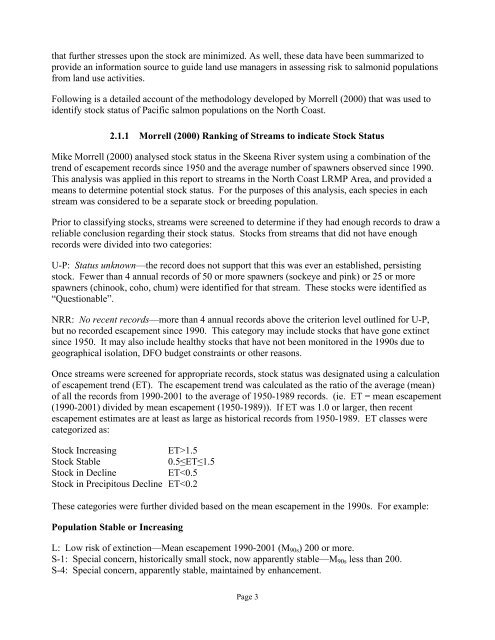Report Template - Ministry of Forests, Lands and Natural Resource ...
Report Template - Ministry of Forests, Lands and Natural Resource ...
Report Template - Ministry of Forests, Lands and Natural Resource ...
Create successful ePaper yourself
Turn your PDF publications into a flip-book with our unique Google optimized e-Paper software.
that further stresses upon the stock are minimized. As well, these data have been summarized to<br />
provide an information source to guide l<strong>and</strong> use managers in assessing risk to salmonid populations<br />
from l<strong>and</strong> use activities.<br />
Following is a detailed account <strong>of</strong> the methodology developed by Morrell (2000) that was used to<br />
identify stock status <strong>of</strong> Pacific salmon populations on the North Coast.<br />
2.1.1 Morrell (2000) Ranking <strong>of</strong> Streams to indicate Stock Status<br />
Mike Morrell (2000) analysed stock status in the Skeena River system using a combination <strong>of</strong> the<br />
trend <strong>of</strong> escapement records since 1950 <strong>and</strong> the average number <strong>of</strong> spawners observed since 1990.<br />
This analysis was applied in this report to streams in the North Coast LRMP Area, <strong>and</strong> provided a<br />
means to determine potential stock status. For the purposes <strong>of</strong> this analysis, each species in each<br />
stream was considered to be a separate stock or breeding population.<br />
Prior to classifying stocks, streams were screened to determine if they had enough records to draw a<br />
reliable conclusion regarding their stock status. Stocks from streams that did not have enough<br />
records were divided into two categories:<br />
U-P: Status unknown—the record does not support that this was ever an established, persisting<br />
stock. Fewer than 4 annual records <strong>of</strong> 50 or more spawners (sockeye <strong>and</strong> pink) or 25 or more<br />
spawners (chinook, coho, chum) were identified for that stream. These stocks were identified as<br />
“Questionable”.<br />
NRR: No recent records—more than 4 annual records above the criterion level outlined for U-P,<br />
but no recorded escapement since 1990. This category may include stocks that have gone extinct<br />
since 1950. It may also include healthy stocks that have not been monitored in the 1990s due to<br />
geographical isolation, DFO budget constraints or other reasons.<br />
Once streams were screened for appropriate records, stock status was designated using a calculation<br />
<strong>of</strong> escapement trend (ET). The escapement trend was calculated as the ratio <strong>of</strong> the average (mean)<br />
<strong>of</strong> all the records from 1990-2001 to the average <strong>of</strong> 1950-1989 records. (ie. ET = mean escapement<br />
(1990-2001) divided by mean escapement (1950-1989)). If ET was 1.0 or larger, then recent<br />
escapement estimates are at least as large as historical records from 1950-1989. ET classes were<br />
categorized as:<br />
Stock Increasing ET>1.5<br />
Stock Stable 0.5≤ET≤1.5<br />
Stock in Decline ET

















